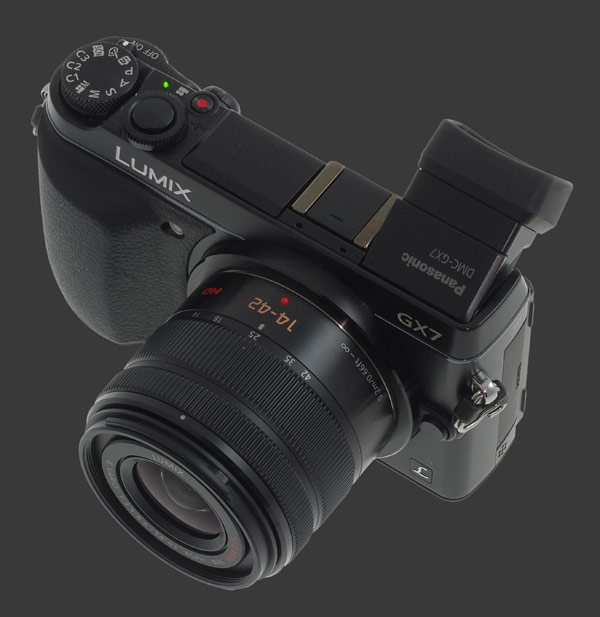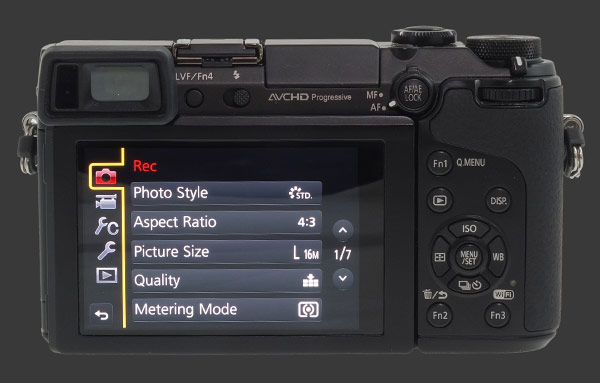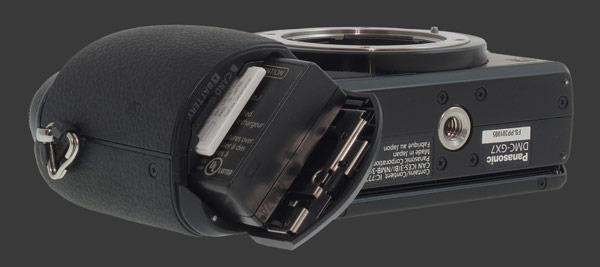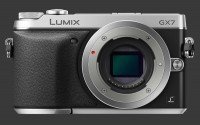Panasonic Lumix DMC-GX7 Review
Panasonic Lumix DMC-GX7 Introduction
The Panasonic Lumix DMC-GX7 is the company's latest flagship mirrorless camera. It uses a 16 MP LiveMOS Micro Four-Thirds sensor with a sensitivity range from ISO 125 to 25600. It can record full 1080p HD video at 60 FPS and images at 5 FPS. The GX7 is the most sophisticated camera Panasanic has produced to date.
The GX7 aims at advanced users looking for a capable and efficient camera. This one has plenty of external controls, including dual control-dials. There is also a rare tilting 2.8 megapixels EVF with 0.7X magnification. This is the highest resolution EVF around and it also manages to show nearly 100% of the AdobeRGB color-space.
This new flagship camera is the only Panasonic mirrorless to feature built-in image-stabilization. This is an immense step forward is it allows the GX7 to stabilize legacy lenses and, most importantly, use high-end M.Zuiko lenses designed for Micro Four-Thirds cameras with stabilization.
The Panasonic GX7 offers complete manual-controls, including custom WB, manual focus, spot metering and class-leading AEB with up to 7 frames. It features a dual-axis digital-level which is visible in the EVF and the 3" tiling touchscreen LCD with 1 megapixel of resolution. It offers built-in WiFi and NFC to round-off its main features.
Its lens mount makes the GX7 compatible with a growing number of Micro Four-Thirds lenses which are often designed for compactness and are now built by several manufacturers.
This digital camera review analyses the usability, image quality and performance of the Panasonic Lumix DMC-GX7.
Panasonic Lumix DMC-GX7 Features
Sensor
- 16 Megapixels CMOS Four-Thirds sensor
- Sensor-Shift image-stabilization
- Micro Four-Thirds lens mount
- Built-in ultra-sonic dust-reduction
Exposure
- ISO 125 - 25600 with Mechanical-Shutter
- ISO 125 - 3200 with Electronic-Shutter
- Intelligent & Standard Auto ISO, with customizable limit 400 - 25600
- 1/8000 Maximum shutter-speed
- 60s Minimum speed for Mechanical-Shutter
- 1s Minimum speed for Electronic-Shutter
- PASM Exposure modes with Program-Shift
- Multi-Segment, Center-Weighed and Spot metering
- Exposure-Compensation, ±5, 1/3 EV increments
- AEB, 3 - 7 frames, 1/3 - 1 EV increments
- Forced, Redeye, Slow-Sync, Slow-Sync Redeye, Off flash modes
- Flash-Compensation, ±3, 1/3 increments
- Manual-Flash, 1/128 - 1 output power
- Flash wireless control, 4 channels
- First or second curtain sync
Image Parameters
- Automatic, 5 presetsSunny, Cloudy, Shade, Tungsten, Flash, Kelvin and 2 custom white-balance settings
- White-balance fine-tuning along 2 axis in 19 steps
- WB Bracketing, 3 frames, 2 step sizes, 2 axis
- Adjustable contrast, sharpness, saturation and noise-reduction, 11 steps each
- 5 Color and 1 B&W modes
- sRGB or Adobe RGB color spaces
Drive
- Continuous Drive, 5 FPS without preview, 4 FPS with preview, Unlimited JPEG or 9 RAW
- Self-timer, 2s, 10s or 3 shots @ 10 seconds
- Interval-Timer, 1 - 9999 frames, 1s to 100 minute interval, immediate or delayed start
- Multiple-Exposure, 3 frames
- Optional Auto Gain for Multiple-Exposure
- Automatic HDR from AEB at 1 - 3 EV increments
- Optional Auto Align for HDR capture
- Optional Shutter-Delay
Focus
- Single-shot autofocus (AF-S), continuous autofocus (AF-C) or manual-focus (MF)
- Pinpoint, Center-point, 23-Points, Subject Tracking and Face-Detect contrast-detect autofocus
- Optional Quick-Shift autofocus
- Optional MF magnification
- Optional AF-Assist lamp
Display & Viewfinder
- 0.4" Tilting EVF, 2.8 megapixels
- Eye-Start sensor
- 3" Tilting touchscreen LCD, 1 megapixel
- Optional live-histogram
- Optional guidelines, 3 types
- Optional blinking highlight
- Optional focus peaking, 3 levels
- Adjustable brightness, 7 steps
- Adjustable saturation, 7 steps
- Adjustable color, 11 steps, 2 axis
Output Processing
- 4:3 Native aspect ratio
- 3:2, 16:9 & 1:1 cropped aspect ratios
- 12, 8 and 4 Megapixels mode
- JPEG, RAW, RAW+JPEG capture
- 2 JPEG Compression qualities
- Adjustable Tone-Curve, 11 levels, for shadows and highlights
- 3 Tone-Curve memories
- Optional long-shutter noise-reduction
- Optional Vignetting Correction
- Optional Contrast Enhancement, 3 levels
- Optional Resolution Enhancement, 4 levels
- Optional Face-Recognition
Video
- 1080p @ 60 FPS with MPEG-4 codec
- 1080p & 720p @ 60 FPS with AVCHD codec
- 720p & VGA @ 30 FPS with MPEG-4 codec
- Built-in stereo microphone
- Audio-input gain, 4 steps
- Audio-meters, 2 channels
- Optional Wind-Filter
Connectivity
- HDMI (1080p) output
- USB 2.0 connectivity
- WiFi (802.11b/g/n)
- NFC-F (ISO/IEC 18092)
Misc
- Dual control-dials
- Traditional mode-dial
- Combined AE-L/AF-L button
- 4 Customizable buttons
- Depth-of-field preview
- Lithium-Ion battery
- SDXC memory
Panasonic Lumix DMC-GX7 Capability - What can it do?
The Panasonic Lumix DMC-GX7 is a full-featured digital camera. It is one of the most advanced mirrorless on the market. As the first and currently only Panasonic that offers built-in stabilization, the GX7 opens possibilities by allowing slower shutter-speeds hand-held with non-stabilized lenses. This is particularly attractive for using legacy lenses since the Micro Four-Thirds mount is one of the most adaptable.
Lenses strongly influence the suitability of a camera. Native Micro Four-Thirds lenses are more numerous than those for other mirrorless systems. Additionally, as a derivative of the Four-Thirds mount, most lenses for that mount can be used via an adapter on the GX7 with full functionality, including autofocus.
Manufacturers currently offer Micro Four-Thirds lenses covering a focal-range of 7 to 300mm, equivalent to 14 - 600mm. This goes from an extremely wide-angle to super-telephoto, covering most needs. Notably absent from the line-up are specialized Tilt-Shift lenses. There are very few macro lenses and not so many ultra-bright ones for Micro Four-Thirds. The 2X crop-factor of the GX7 gives it more depth-of-field than most DSLRs. Depending on your photography, this is an advantage or not.

The Panasonic GX7 offers a class-leading shutter-speed range of 1/8000s to 60s which goes can freeze ultra-fast action and making light-trails at night. Bulb exposures are limited to 2 minutes which means that it cannot do start trails in-camera. Auto-Exposure Bracketing also offers a class-leading 7-frame bracket. This is usable for Exposure-Fusion or HDR, which this camera can do itself.
While it has full PASM manual controls for both stills and video, the GX7 only offers an Exposure-Priority Live-View in Manual mode. Its white-balance options extensive with Auto, Preset, Kelvin and Custom modes. Every single on of these is fine-tunable in 19 steps along 2 axis. This makes the GX7 capable of handling any type of light-source.
Manual-Focus is incredibly easy on this mirrorless. Not only does it have the highest-resolution EVF ever made, with a whopping 2.8 megapixels, it is also equipped with MF Assist and customizable Focus Peaking. This lets photographers precisely see the area in-focus, better than with any type of SLR.

The superb viewfinder of the GX7 is tiltable, like the large 3" touchscreen LCD on the back of the camera. This makes it usable for shooting at odd angles, especially in crowded places where holding the camera at arms-length is not ideal.
There is a standard hot-shoe on this camera, right next to the viewfinder. This lets it support an add-on flash but we suspect the EVF will not be able to tilt with one mounted. Instead, one can use this Panasonic's wireless flash feature which remotely fires flashes using one of 4 channels. There is also a built-in flash with a plethora of options, including manual power from 1/128th to full-power.
Among all its features, the Panasonic Lumix DMC-GX7 lacks one compared to a handful of mirrorless cameras: The GX7 is not weather-sealed or freezeproof. As such it is not suitable for photography in adverse weather.
Panasonic Lumix DMC-GX7 Usability - How easy is it to use?
The Panasonic Lumix DMC-GX7 has a boxy shape with a short rubber grip and protruding EVF. The grip has a broad curve which relatively comfortable for such a compact camera. Rubber wraps from the grip to the back of the camera to provide traction. There are strap eyelets on either side with the grip-side one in a poor position that constantly digs into the index-finger.
The top plate of the GX7 is not so busy with a few controls packed together above the grip and a hot-shoe near a stereo microphone. The EVF occupies the extreme-left which makes it perfectly comfortable and it can be tilted 90° upwards.

On the right-side, there is a dedicated video-record button just behind a two-stage shutter-release surrounded by the main control-dial. A traditional mode-dial is to the right of the shutter-release. Just below the mode-dial, there is a simple power-switch with a strong detent, making accidentally powering on the GX7 impossible.
The Video Record button is flush with the surface of the camera. It starts recording video almost instantly yet stops such as the last second or so gets chopped. The exact delay depends on the video mode but is roughly ½s for 1080p. This occurs whether the camera is in Video mode or not. Luckily, at least there is a Video mode which lets one accurately prepare framing for video.
The shutter-release has a moderate amount of travel with a soft halfway point to minimize shaking the camera when taking a shot. The control-dial around is easy to reach and has good detents, just like the textured mode-dial. There are 11 positions on the mode-dial:
- All the traditional PASM modes get their own position. P offers Program-Shift.
- Video mode allows recording of video in any PASM mode, as selected in the video menu.
- Three custom modes. C1 and C2 store a single set of parameters while C3 offers 3 memories for parameters.
- Intelligent Auto mode offers automatic operation while letting users specify EC and WB directly.
- The Scene position groups all 24 modes.
- The Effect position groups all 8 effects.
The back of the GX7 is dominated by a 3" touchscreen LCD with 1 megapixel. It is mounted on an impressively sturdy tilting hinge which can be angled downwards 45° for overhead shots or up to 85° upwards. Luckily, the touchscreen feature can be disabled to avoid accidental actions.

Visibility of the display is very good, so is the anti-reflective coating. The viewing angle is quite impressive. The display refreshes quickly and follows motion well. This camera is sadly not Exposure-Priority, so exposure is not always previewed correctly. There is a optional misleading live-histogram based on the brightness of the display rather than that of the metered exposure.
A high number of controls cover the remainder of back. Just beside the EVF is a customizable button. By default it toggles the EVF but, since this is done automatically by the essential Eye-Start sensor, it can be assigned to a useful function. Right next to it is a mechanical spring-loaded flash-release button.
At the upper right corner of the LCD is the combined AE-L/AF-L button, surrounded by the AF/MF switch. Each of these work exactly as expected. Further right is the camera's second control-dial. This dial is clickable which toggles controls of EC. This modal interface is not ideal since it is both accident-prone and time-consuming.
There are buttons arranged as a 4-way controller, including central Menu button, plus no fewer than 5 extra buttons. The top one and two lower ones are customizable. By default, Fn1 invokes an icon Quick Menu to change common settings. In an impressive amount of customization, the menu itself is user-configurable.
Still above the 4-way controller, the Playback and Disp button work as usual. The former toggles between Capture and Playback mode, while the former cycles through various display modes. Each direction of the controller is assigned a function:
- Up: Selects ISO. There are options from 200 to 25600, plus a low 125 when ISO Expansion is enabled. Two Auto ISO modes work slightly differently: One selects sensitivity depending on shutter-speed only, the other also uses subject motion.
- Right: Selects White-Balance. The screen which appears when Right is pressed is also used to fine-tune white-balance or enable WB bracketing.
- Down: Selects a drive mode: Off, Single-Shot, ContinuousSuper-High Speed (40 or 10 FPS @ 4MP) , High-Speed (5 FPS) without preview, Medium Speed (4 FPS) or Low speed (2 FPS), Bracketing and Self-Timer2s, 10s or 3-frames at 10s. There is no difference between Off and Single-Shot as far as we can tell.
- Left: Selects the AF mode: Pinpoint, Single-Point, Automatic 23-Area, Tracking and Face-Detect. The focus point or area, depending on the mode, can be set by pressing Down fro there. Pinpoint allows the selection of an exact point while Single-Point allows the selection of an image-area. Four area-sizes are available.
The Panasonic Lumix DMC-GX7 feels light yet sturdy. The body is made of rigid plastic with metal top and bottom plates. The battery-compartment door has a little flex in the hinge but everything is well built. At the bottom there is a metal tripod mount directly inline with the optical center of the camera. This is ideal for panoramic photography.

Ergonomics of the GX7 are good. There are dual control-dials and buttons for every important settings, plus an outstanding number of customizable buttons. The modal EC function which Panasonic insists of implementing is annoying at best. The eyelet on the grip side is a pain after prolonged shooting but should not be a problem for casual photography.
 |
Please Support Neocamera
All information on Neocamera is provided free of charge yet running this website is a huge endeavor. Purchases made via affiliate links found throughout the site help keep it running and up-to-date. There is no additional cost to you, so please consider buying via these links to our affilates:
If you found any information on this site valuable and did not purchase via our affiliate links, please considering donating via PayPal:
Any amount will be greatly appreaciated. Thank you for your support!
Panasonic DMC-GX7 Highlights

Sensor-Size: 17 x 13mm

Actual size when viewed at 100 DPI
| 16 Megapixels Mirrorless | ISO 125-25600 |
| Micro Four-Thirds Mount 2X FLM | Shutter 1/8000-60s |
| 2-Axis Built-in Stabilization | Full manual controls, including Manual Focus |
| 0.40" Built-in EVF 2.8 Megapixels (0.70X) | Custom white-balance with 2 axis fine-tuning |
| Automatic Eye-Start sensor | Spot-Metering |
| 2 Axis Digital Level | Hot-Shoe |
| Built-in Dust Reduction | Stereo audio input |
| 5 FPS Drive, Unlimited Images | Lithium-Ion Battery |
| 1920x1080 @ 60 FPS Video Recording | Secure Digital Extended Capacity |
| 3" LCD 1 Megapixels |
Updates
2025.01.18

Fujifilm GFX 2025 Lens Roundup
Lens Review roundup of Fujifilm GFX Medium-Format lenses. Quality, performance and handling of the GF20-35mm F/4R WR, GF30mm F/3.5 Tilt-Shift and the GF55mm F/1.7.
2024.11.18

Best 2024 Photography Gifts for Every Budget
Great gifts for photographers and photo enthusiasts selected for every budget among the best products of 2024.
2024.08.07

Eye Protection Tips for Professional Photographers
The four main considerations for professional photographers regarding eyewear.
2024.07.14

Fujifilm X100VI Review
Flagship fixed-lens compact digital camera with a 40 MP sensor and Image-Stabilization, a first for the series. Retro design featuring dual control-dials, plus direct ISO, Shutter-Speed and EC dials. Its hybrid viewfinder can switch between EVF and OVF mode.
2024.05.09

Fujifilm GFX100 II Review
Flagship 102 Megapixels Medium-Format Mirrorless Digital Camera with 8-Stop 5-Axis IBIS, 8 FPS Drive, 8K Video and 400 MP Super-Resolution capture in a weatherproof and freezeproof body with dual control-dials and dual memory-card slots.
2024.04.03

Fujifilm X-T5 Review
Newest Fujifilm flagship boasting a 40 MP APS-C sensor, 5-axis IBIS with 7-stop efficiency, 15 FPS continuous drive, 6.2K Video capture, dual control-dials and dual SDXC UHS-II slots in a sturdy weatherproof and freezeproof body.
2023.11.20

Best Digital Cameras of 2023
Find out which are the Best Digital Cameras of 2023. All the new Mirrorless Digital Cameras from entry-level to high-end professional.
2023.07.10

Fujifilm X-H2 Review
40 Megapixels APS-C Hybrid Mirrorless Digital Camera with 7-stop IBIS. Fastest shutter ever and 8K video capture. Large builtin EVF with 0.8X magnification and 5.8 MP, plus an Eye-Start Sensor. Packed with features and large number of controls in a weatherproof and freezeproof body.
2023.05.07

Sony FE 20-70mm F/4G Review
Review of the unique Sony FE 20-70mm F/4G lens. The optical zoom of this lens spans ultra-wide-angle and medium focal-length coverage, making it one of the most versatile Full-Frame lenses on the market.
2023.01.15

Huion Inspiroy Dial 2 Review
Review of the Huion Inspiroy Dial 2 tablet, a medium sized drawing surface with dual dials and customizable buttons. Connects via USB-C or Bluetooth 5.0 with Windows, Linux and Android support.
2022.12.08

How to Pack for a Photo Trip
Find out how to pack for a travel photography trip, carry your gear safely while meeting airline regulations.
2022.11.13

Best Digital Cameras of 2022
The best digital cameras of 2022. A short list of the most outstanding models in their respective categories. Choose one for yourself or as a gift.














